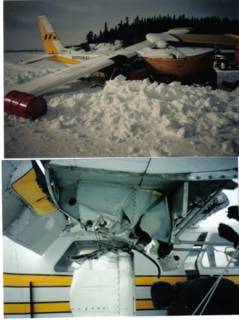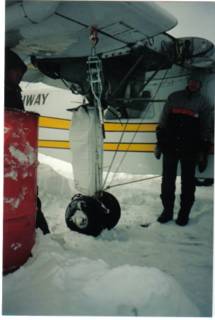Friday, December 10, 2004
Pauingassi Snares Two Victims
I was flying for an outfit operating off Drunken Point, just north of Gimli, Manitoba. It was around early January, and we were supplying northern communities with passenger and freight service.
The day in particular, three of our aircraft were servicing the communities of Little Grand Rapids and Pauingassi, 9 miles apart on the Fishing-Family Lake chain. One aircraft would go to the gravel runway at Little Grand Rapids, and the other two would use the ice-strip in Pauingassi.
I was the first to depart base, flying a Cessna 207 with oversized gear, full to the nuts with freight. I loved flying freight. A lot of the time, freight is more intelligent than passengers and doesn't puke on you. Anyways, it was afternoon sched and these were our last trips of the day.
I made Pauingassi, unloaded, and headed back south. I talked to the two other pilots, as they were close behind me.
It was a nice afternoon, I was about halfway back and daydreaming, when I heard an aircraft call our base and tell them the C-207 was down in Pauingassi with gear problems. Funny, unless the wheels fell off when I took off, this aircraft is fine. Some more communication ensued, and we found out it was our Britten Norman Islander that had experienced gear trouble on landing in Pauingassi. Nobody was hurt, and the pilot and single passenger were picked up by our other aircraft and transported south.
When the pilot returned, he told us he clipped the snowbank on landing and the gear was damaged. I had a bad feeling in my stomach as Islander gear is very strong and if it was damaged, the airplane must have taken a good whack. We arranged to have a local fellow guard the airplane overnight so the local gas-sniffers ( bad problem ) wouldn't get high off of the AVGAS and then torch the airplane.
The next day, Jim Johnson ( the owner ) and I would take the unopened winter road to Pauingassi and inspect the airplane.
We left early the next morning, crossed Lake Winnipeg, and bounced up the winter road. The road was in poor shape as the freeze-up was being hindered by lots of snow, and there were lots of wet spots. We made it to Little Grand and found they were still flooding the lake crossing with Bombardiers and augers. Warily we crossed the lake in Jim's GMC 4x4. The water was so deep in spots it was up to the running boards. This was a little disconcerting.
We made it to Pauingassi and surveyed the airplane. HOLY SMOKES! This airplane will not be patched and flown out. The damage was substantially more than we had been led to believe. We pulled out the seats, survival gear, head-sets, radios, and anything else that might grow legs in the next day or two. Returning to base after another 4 hour trip south, we had to put Jim's 4x4 in the hangar for two days to melt the ice we had picked up off of it ( January, remember, cold ).
A couple of days later we returned by airplane to move the airplane and prepare it to be salvaged and trucked out when the ice thickness permitted. As we were jury-rigging the gear leg, a pickup truck came fish-tailing by us dangerously close doing about 80 mph, as the ice-strip doubles as the winter road. There was a massive native fellow on the passenger side with his hands over the defrost vents, and he looked wet. A ski-doo pulled up a short time later and told us that the big fellow had just dropped his grader through the ice and had popped back to the surface and had crawled to safety through the ice chunks. One tough son of a b........! The grader went to the bottom in 90' of water.
We finished up our work and moved the airplane. We had jacked it up, bent the gear straight, and cabled it straight. We loaded up and flew home, feeling a sense of accomplishment.
Within a short period, the aircraft was salvaged and returned to our base. The wing was so badly damaged, it never flew again. An Islander wing is a one-piece, stressed, anhedral wing, and it would have been too costly. She was parted out, so the spirit of old C-GSGK still flies on in a number of other airplanes.
Life continued, and I waited for the next adventure. I tell you, this sure beats an office job!!!!!!

Landing on the ice is not overly difficult, but the #1 rule is land BETWEEN the snowbanks...

Les was not a scholar, philosopher, theologian, or even a lady's man. But dang, could he cable.....
The day in particular, three of our aircraft were servicing the communities of Little Grand Rapids and Pauingassi, 9 miles apart on the Fishing-Family Lake chain. One aircraft would go to the gravel runway at Little Grand Rapids, and the other two would use the ice-strip in Pauingassi.
I was the first to depart base, flying a Cessna 207 with oversized gear, full to the nuts with freight. I loved flying freight. A lot of the time, freight is more intelligent than passengers and doesn't puke on you. Anyways, it was afternoon sched and these were our last trips of the day.
I made Pauingassi, unloaded, and headed back south. I talked to the two other pilots, as they were close behind me.
It was a nice afternoon, I was about halfway back and daydreaming, when I heard an aircraft call our base and tell them the C-207 was down in Pauingassi with gear problems. Funny, unless the wheels fell off when I took off, this aircraft is fine. Some more communication ensued, and we found out it was our Britten Norman Islander that had experienced gear trouble on landing in Pauingassi. Nobody was hurt, and the pilot and single passenger were picked up by our other aircraft and transported south.
When the pilot returned, he told us he clipped the snowbank on landing and the gear was damaged. I had a bad feeling in my stomach as Islander gear is very strong and if it was damaged, the airplane must have taken a good whack. We arranged to have a local fellow guard the airplane overnight so the local gas-sniffers ( bad problem ) wouldn't get high off of the AVGAS and then torch the airplane.
The next day, Jim Johnson ( the owner ) and I would take the unopened winter road to Pauingassi and inspect the airplane.
We left early the next morning, crossed Lake Winnipeg, and bounced up the winter road. The road was in poor shape as the freeze-up was being hindered by lots of snow, and there were lots of wet spots. We made it to Little Grand and found they were still flooding the lake crossing with Bombardiers and augers. Warily we crossed the lake in Jim's GMC 4x4. The water was so deep in spots it was up to the running boards. This was a little disconcerting.
We made it to Pauingassi and surveyed the airplane. HOLY SMOKES! This airplane will not be patched and flown out. The damage was substantially more than we had been led to believe. We pulled out the seats, survival gear, head-sets, radios, and anything else that might grow legs in the next day or two. Returning to base after another 4 hour trip south, we had to put Jim's 4x4 in the hangar for two days to melt the ice we had picked up off of it ( January, remember, cold ).
A couple of days later we returned by airplane to move the airplane and prepare it to be salvaged and trucked out when the ice thickness permitted. As we were jury-rigging the gear leg, a pickup truck came fish-tailing by us dangerously close doing about 80 mph, as the ice-strip doubles as the winter road. There was a massive native fellow on the passenger side with his hands over the defrost vents, and he looked wet. A ski-doo pulled up a short time later and told us that the big fellow had just dropped his grader through the ice and had popped back to the surface and had crawled to safety through the ice chunks. One tough son of a b........! The grader went to the bottom in 90' of water.
We finished up our work and moved the airplane. We had jacked it up, bent the gear straight, and cabled it straight. We loaded up and flew home, feeling a sense of accomplishment.
Within a short period, the aircraft was salvaged and returned to our base. The wing was so badly damaged, it never flew again. An Islander wing is a one-piece, stressed, anhedral wing, and it would have been too costly. She was parted out, so the spirit of old C-GSGK still flies on in a number of other airplanes.
Life continued, and I waited for the next adventure. I tell you, this sure beats an office job!!!!!!

Landing on the ice is not overly difficult, but the #1 rule is land BETWEEN the snowbanks...


Les was not a scholar, philosopher, theologian, or even a lady's man. But dang, could he cable.....


















